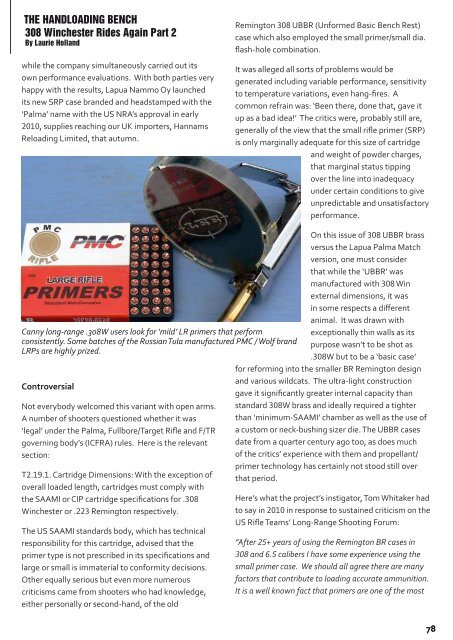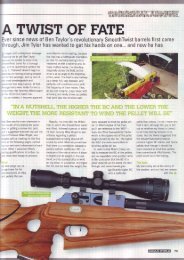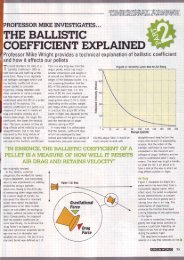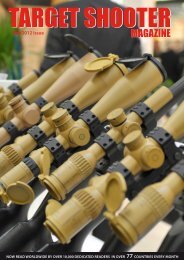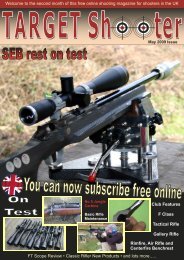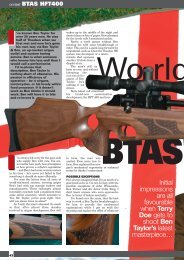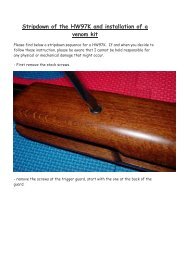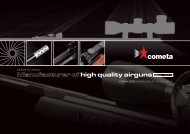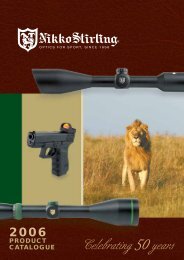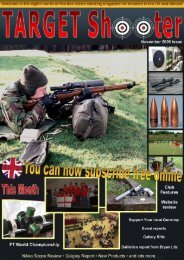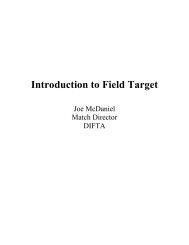February 2012 Issue - Target Shooter Magazine
February 2012 Issue - Target Shooter Magazine
February 2012 Issue - Target Shooter Magazine
Create successful ePaper yourself
Turn your PDF publications into a flip-book with our unique Google optimized e-Paper software.
THE HANDLOADING BENCH<br />
308 Winchester Rides Again Part 2<br />
By Laurie Holland<br />
while the company simultaneously carried out its<br />
own performance evaluations. With both parties very<br />
happy with the results, Lapua Nammo Oy launched<br />
its new SRP case branded and headstamped with the<br />
‘Palma’ name with the US NRA’s approval in early<br />
2010, supplies reaching our UK importers, Hannams<br />
Reloading Limited, that autumn.<br />
Remington 308 UBBR (Unformed Basic Bench Rest)<br />
case which also employed the small primer/small dia.<br />
flash-hole combination.<br />
It was alleged all sorts of problems would be<br />
generated including variable performance, sensitivity<br />
to temperature variations, even hang-fires. A<br />
common refrain was: ‘Been there, done that, gave it<br />
up as a bad idea!’ The critics were, probably still are,<br />
generally of the view that the small rifle primer (SRP)<br />
is only marginally adequate for this size of cartridge<br />
and weight of powder charges,<br />
that marginal status tipping<br />
over the line into inadequacy<br />
under certain conditions to give<br />
unpredictable and unsatisfactory<br />
performance.<br />
THE HANDLOADING BENCH<br />
308 Winchester Rides Again Part 2<br />
By Laurie Holland<br />
The Palma Match shield is topped by a stylised eagle and wreath emblem as reproduced on the Sierra ‘Palma’<br />
MatchKing bullet carton. This is one of the very few products allowed to use the name and image.<br />
Canny long-range .308W users look for ‘mild’ LR primers that perform<br />
consistently. Some batches of the Russian Tula manufactured PMC / Wolf brand<br />
LRPs are highly prized.<br />
Controversial<br />
Not everybody welcomed this variant with open arms.<br />
A number of shooters questioned whether it was<br />
‘legal’ under the Palma, Fullbore/<strong>Target</strong> Rifle and F/TR<br />
governing body’s (ICFRA) rules. Here is the relevant<br />
section:<br />
T2.19.1. Cartridge Dimensions: With the exception of<br />
overall loaded length, cartridges must comply with<br />
the SAAMI or CIP cartridge specifications for .308<br />
Winchester or .223 Remington respectively.<br />
The US SAAMI standards body, which has technical<br />
responsibility for this cartridge, advised that the<br />
primer type is not prescribed in its specifications and<br />
large or small is immaterial to conformity decisions.<br />
Other equally serious but even more numerous<br />
criticisms came from shooters who had knowledge,<br />
either personally or second-hand, of the old<br />
On this issue of 308 UBBR brass<br />
versus the Lapua Palma Match<br />
version, one must consider<br />
that while the ‘UBBR’ was<br />
manufactured with 308 Win<br />
external dimensions, it was<br />
in some respects a different<br />
animal. It was drawn with<br />
exceptionally thin walls as its<br />
purpose wasn’t to be shot as<br />
.308W but to be a ‘basic case’<br />
for reforming into the smaller BR Remington design<br />
and various wildcats. The ultra-light construction<br />
gave it significantly greater internal capacity than<br />
standard 308W brass and ideally required a tighter<br />
than ‘minimum-SAAMI’ chamber as well as the use of<br />
a custom or neck-bushing sizer die. The UBBR cases<br />
date from a quarter century ago too, as does much<br />
of the critics’ experience with them and propellant/<br />
primer technology has certainly not stood still over<br />
that period.<br />
Here’s what the project’s instigator, Tom Whitaker had<br />
to say in 2010 in response to sustained criticism on the<br />
US Rifle Teams’ Long-Range Shooting Forum:<br />
”After 25+ years of using the Remington BR cases in<br />
308 and 6.5 calibers I have some experience using the<br />
small primer case. We should all agree there are many<br />
factors that contribute to loading accurate ammunition.<br />
It is a well known fact that primers are one of the most<br />
important of these factors as they start the whole<br />
process going. What I found over the years is that there<br />
is a large variance in ignition using large rifle primers.<br />
Not just from brand to brand but from lot to lot within<br />
the same brand. No big revelation here, I’m sure we all<br />
have experienced this. Using small rifle primers I have<br />
found very little to no variance between lot to lot within<br />
a brand and minor variance from brand to brand. This<br />
equates to a much easier time developing a precision<br />
load and sustaining that load over a long period of<br />
time. Other factors affected by this are the reduced<br />
need to stock up on a certain component (primers can<br />
deteriorate over time) and less barrel wear wasted in<br />
testing.<br />
...So, what’s the point? It is not 3-5 fps better ES<br />
(although I have found it to be better than that), nor is<br />
it that this case will produce ammo more accurate than<br />
the best LRP case loads (a great load is a great load<br />
no matter what you use). The big gain, in my opinion,<br />
is that it is much easier to find that great long range<br />
load with these SRP cases than it is with LRP cases.<br />
Everyone has access to this case now use it if you want<br />
or not, the choice is up to you.”<br />
The US Palma team reported that the SRP brass<br />
reduced velocity spreads (ES) by around 30%,<br />
sometimes more, with its standard load of the 155gn<br />
Sierra ‘Palma’ MK over Hodgdon VarGet. 15-round<br />
strings recorded ES values of 12-18 fps and SDs of 4-5<br />
fps. The sole downside was a reduction in the MV but<br />
this could be rectified by adjusting the charge weight.<br />
Four SRP brands were tried, purchased over the<br />
counter in ordinary gunshops and all performed<br />
well with little lot to lot variation. Low temperature<br />
questions were faced head on by placing SRP<br />
ammunition in a freezer overnight and test firing it<br />
over a chronograph immediately afterwards which<br />
was done without any serious or safety related<br />
problems such as hang-fires, although a reduction in<br />
the average MV was (unsurprisingly) recorded.<br />
78 79


